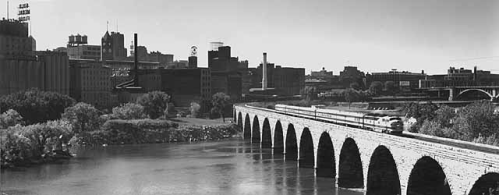The Hidden Threat to the Twin Cities’ Water Supply
 Saturday, March 20, 2021 at 8:39AM |
Saturday, March 20, 2021 at 8:39AM |  River Matters |
River Matters | By John Anfinson, Guest Columnist

"If the cutoff wall failed today, a million people would lose their primary water source"
St. Anthony Falls lies one tick of the geologic clock from ending a 12,000-year journey up the Mississippi River from St. Paul. When that tick slips, the Twin Cities could lose much of its water supply. Holding back the clock is a dam that stands1,850 feet long, 40 feet high and four to six and one-half feet wide, a dam no one can see. It lies under the Mississippi River, beneath the limestone and shale riverbed. For over 144 years it has withstood the relentless demands of nature to finish its task. How much longer will it last?
The St. Anthony Falls Reservoir is Key to the Twin Cities Water Supply
The Minneapolis Water Department draws 100% of its water from the Mississippi River. Their intake lies four and one-quarter miles above St. Anthony Falls and depends on a reservoir created by dams you can and cannot see. Forty percent of this water goes to some 430,000 Minneapolis residents, and Minneapolis supplies 110,000 residents of Golden Valley, Crystal, New Hope, Columbia Heights, Hilltop, New Brighton, and Edina’s Morningside Neighborhood. These suburbs take 22%. Minneapolis delivers another 38% to institutional, commercial, and industrial users. Among them, the University of Minnesota, Metropolitan Airports Commission and Hennepin Energy Recovery Center count among the largest customers and together consume 5%. Bloomington mixes its well water with Minneapolis river water. (Map)
Saint Paul Regional Water Services pulls 75% of its supply from the Mississippi nine miles above the falls. It provides water to 425,000 residents, delivering retail water service to Falcon Heights, Lauderdale, Maplewood, Mendota, Mendota Heights, and West Saint Paul and wholesale service to Arden Hills, Little Canada, and Roseville. St. Paul sends limited retail water to Sunfish Lake, South St. Paul, Lilydale and Newport. (Map)
Nearly one million Twin Citians depend on the Mississippi River for their household water. Major institutional, commercial and industrial enterprises count on it. How much water does downtown Minneapolis consume on any given work day? What about downtown St. Paul or the International Airport or University of Minnesota or all the K through 12 schools or the many hospitals? What would happen with a sudden, catastrophic loss of the St. Anthony Falls reservoir?
St. Pauls’ water supply lakes hold 3.6 billion gallons, and the city has ten wells that can distribute an average day’s needs to its customers. These reserves would see St. Paul and its dependents through a short-term emergency, but in the long term, St. Paul must draw from the Mississippi River. Minneapolis has no wells and no lake system. Its “finished reserve” would last three days. Minneapolis relies entirely on the Mississippi River and on the reservoir created by the dams at St. Anthony Falls for its water supply, including firefighting.
The Hidden Threat
In 1869, St. Anthony Falls and the reservoir nearly disappeared. The crisis began below the Mississippi River. Workers had been tunneling through the soft St. Peter Sandstone that lies under 18 inches of shale and up to 25 feet of limestone. They ran their tunnel under Hennepin Island, then under the river, and after 2,000 feet had reached Nicollet Island, where William Eastman and his partners planned to erect a mill.
On the morning of October 4, water started pouring into the Eastman Tunnel’s upper end, eating away the sandstone walls. Within hours, the six-foot-square tunnel grew into a cavern 10 to 90 feet wide and 16½-feet deep. The next morning, the limestone riverbed collapsed, forming a large whirlpool. Volunteers hurriedly built a massive raft and floated it over the vortex, which sucked it to the riverbed. They piled on dirt, rocks and debris, but another cave-in occurred between the raft and the shore of Nicollet Island, and they built another raft, and the breach expanded again, and they repeated the triage.
A second, separate whirlpool appeared, and they built more rafts to cap it. As described in historian Lucile Kane’s excellent account, they then celebrated “the triumph of human skill and brain power over the dumb force of nature” Nature took exception, and the river devoured the feeble structures. The power of falling water had turned against the millers.
Thus began a calamity that threatened to undermine the entire riverbed at St. Anthony Falls and end its long journey. Knowing the complexity and urgency of their crisis, Minneapolis looked to the recently established St. Paul District, U.S. Army Corps of Engineers, but navigation, not saving St. Anthony Falls, was its mission. So, the city convincingly argued that losing the falls endangered navigation above the falls. At the lower end of Nicollet Island, the limestone riverbed ends, and the digital geologic clock for St. Anthony Falls hits zero. Without the limestone, the falls would become a long, shallow, unnavigable rapids.
Between 1870 and 1874, the river foiled every fix devised by the Corps. Water flowing under the limestone’s leading edge was invading the tunnel and cutting new routes through the sandstone. While they balked at the cost and scale of the project, the Corps recognized they had to build a dam or cutoff wall under the river, under the limestone and shale, deep into the sandstone, from one bank to the other. The Corps began construction on July 9, 1874, and finished the cutoff wall on November 24, 1876. A Minneapolis Tribune article of November 20 that year reported that it extended for 1,850 feet and stood 40 feet tall. Not until 1885, however, did the Corps complete its work and leave the falls. They had to finish an apron to protect the falls’ leading edge, construct two roll dams to maintain water over the central falls and fill all the cavities.
General G. K. Warren, a Civil War hero and the first St. Paul District commander, visited falls about 1880 and offered this warning: “Only eternal vigilance will preserve the Falls of St. Anthony.” It is a testament to the Corps’ engineering prowess that their oldest dam on the Mississippi River has lasted so long without fix or failure.
One-hundred and seven years after Warren’s forewarning, the river and geology reminded Minneapolis of how fragile engineering at the falls can be. In 1987, water found its way under the deep foundation of the 90-year-old Lower St. Anthony Falls Hydroelectric Station. Reminiscent of the Eastman Tunnel, the river consumed the sandstone, forming a cavern under the station, draining the upstream reservoir in hours. Over the next few days, the station collapsed.
Why the Corps Must Stay at the Upper St. Anthony Falls (USAF) Lock & Dam
The Eastman Tunnel disaster did not steal Minneapolis or St. Paul’s water supply. Minneapolis started drawing water from the river for residential and commercial use in 1871, and for the next few decades, most people continued using household or community wells or springs. St. Paul did not begin siphoning water from the Mississippi until 1925.
If the cutoff wall failed today, a million people would lose their primary water source. Institutional, commercial and industrial users, including schools at all levels, and the Minneapolis/St. Paul International Airport might have to shut down or dramatically cut back their water consumption. Minneapolis’ reserve would run out in three days. Fire hydrants would quickly run dry. St. Paul would pivot to its emergency reserves, but how long would they last? Both cities could lose their water intakes. The Corps says if the dam at St. Anthony Falls fails, “A head cutting erosion would extend far upstream, affecting roads, bridges, homes, and other infrastructure,” and “It is conceivable that degradation could extend 30 miles upstream, …” In other words, the ensuing rapids would begin cutting down the riverbed until finding its natural slope.
How long would it take plug a breach at St. Anthony Falls and restore the reservoir? How long would it take and how much would it cost to repair the cutoff wall below the river and whatever damage inflicted at the surface? Who would do it?
The Corps of Engineers is the logical choice, and the federal interest is clear and strong. The Corps built the cutoff wall, undertook much of the infrastructure repairs caused by the tunnel collapse and constructed the two roll dams inside the horseshoe dam. They built the lock and own two short sections of the dam. The Corps, however, hopes to leave St. Anthony Falls. Because the Upper St. Anthony Falls Lock closed to navigation permanently in 2015, the Corps wants Congress to deauthorize their navigation and recreation missions, allowing them to dispose of the lock and associated infrastructure. Without a new primary mission, they have no reason to stay.
Given how critical the cutoff wall and dam structures at St. Anthony Falls are to the Twin Cities, that new mission should be water supply. While the Corps portfolio includes a water supply mission, they would contend it is only for dams they have constructed. Yet, without the cutoff wall they built, the reservoir created by the surface dam above would not exist: the cutoff wall makes the reservoir possible.
While it is not clear who owns the cutoff wall, the Corps built it, and they should have a direct interest in the Twin Cities water supply. Losing the St. Anthony Falls reservoir would qualify as a federal disaster, and if, as the Corps suggests, the river would start cutting down the riverbed, “affecting roads, bridges, homes, and other infrastructure” for 30 miles upstream, imagine the economic cost of such losses. As the Corps says in its draft disposition study: “The 19th century architects of the falls recognized that loss of the falls would be catastrophic. With the upstream and downstream development along the river, the same conclusion applies today.”
The Mississippi River will only become more important to the Twin Cities’ water supply. The metro area is growing, and there is a strong push to rely more on the river and less on the already overstressed aquifers tapped by many metro area communities. So, the Twin Cities needs the Corps to remain at St. Anthony Falls, and Congress must give it a water supply mission. The Corps could then continue their already authorized recreation mission, fulfill a critical flood risk mitigation responsibility and facilitate Xcel Energy’s hydroelectric power generation as additional missions. The national economic benefits of these combined missions is immense, especially compared to any commercial navigation that ever passed through the lock, and easily outweighs the federal costs. Ignoring this threat is not an option; consider the consequences – social, economic and political - if the wall fails and no one has heeded General Warren’s portent.













